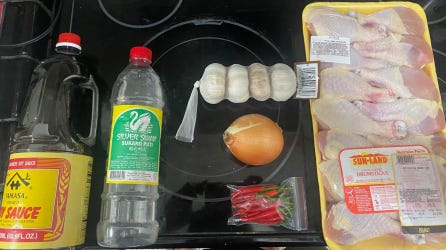My Experiences with Kådun Pika
When I was little, I went to countless parties with my family and there were only a few things I liked: the toys inside of the house and the sodas. But my absolute favorite part about these parties was the food each family brought.
The table is typically filled with various foods and desserts, but one dish stood out from the rest—the Kådun Pika. I got my plate and hot rice, then poured a generous (maybe a little too generous) amount of Kådun Pika over it.
When I tried it, the flavor felt like a heavenly experience with a kick of pepper. The mix of textures and tastes from the chicken, soy sauce and vegetables hit every note I was hoping for, and I still wanted more even after going back for seconds.
I was not the only one who felt that sentiment. It turns out that everyone who tried the Kådun Pika that night filled their Tupperware containers with what was left. From that moment on, I fell in love with the dish and learned to make it for my family at home.
The Deeper Meaning: Community Unity in Parties

Food often sets the tone at any gathering, sparking conversation and connection from the moment people arrive. On Guam, sharing a meal means sharing part of who you are.
Gathering around the table creates space for stories, laughter and shared memory. In these moments, food becomes more than a meal.
Foods like Kådun Pika reflect the cultural significance of sharing a meal as it both satisfies our hunger and bring people together. But what stands out to me is the effort poured into the pot and what makes Kådun Pika, Kådun Pika.
What does Kådun Pika mean?
The term “kådun” (sometimes spelled “kådon”) comes from the CHamoru word “kådu” which means soup, stew or broth. “Pika” translates to spicy or something that contains a lot of spice. Together, it means “spicy stew.”
Its main takeaway is the “donne’” or the pepper that adds spice with the combined tastes and aromas of the herbs all mixed in together.
This dish is not an original delicacy. Kådun Pika’s fiery and delectable taste is similar to the Philippines’ chicken adobo, but what separates them between the three is the donne’ that enhances its savory flavor!
Kådun Pika may not be unique to Guam in origin, but the local twist—thanks to the heat of donne’—makes it a standout favorite at island gatherings. If you're ready to try making it yourself, here's what you'll need to get started.
Ingredients
To prepare this dish, you need a large saucepan and patience, as this dish is time-consuming to prepare. But the end product will not disappoint you!
The ingredients you need are:
- 1 whole chicken (preferably for stewing)
- ½ cup soy sauce
- ¼ cup white vinegar
- 1 whole onion, sliced
- 1 whole garlic, diced
- 2 teaspoons black pepper
- 2 teaspoons Tabasco pepper sauce
- 8 chili peppers, chopped
Directions
Chop the chicken into small bits and pieces. Drumsticks also work well. Put your chicken in a soup pan under medium heat.
Add the onions and garlic into the pot and cook for about 5-10 minutes on medium heat. Cook until it turns slightly brown.
Combine all the remaining ingredients into the pot and let it simmer on medium-low heat for about 30 minutes, or until the chicken is cooked.
Mix after 30 minutes. You can adjust the taste to your liking by adding more soy sauce, black pepper, Tabasco sauce or any other seasoning if necessary.
Serve with a cup of white rice and add donne’ pepper and enjoy!
Feel free to try the recipe out for yourself, as it only requires a few ingredients! You can impress your aunties and uncles at the next family get-together with this dish, and you might just end up becoming the chef for your family.








Aaah, as a CHamoru living in middle-of-nowhere Texas with absolute no access to any of our foods or culture, this hit me with some deep nostalgia. I absolutely love Kådun Pika and now feel compelled to make it this weekend. Si yu'os ma'åse'